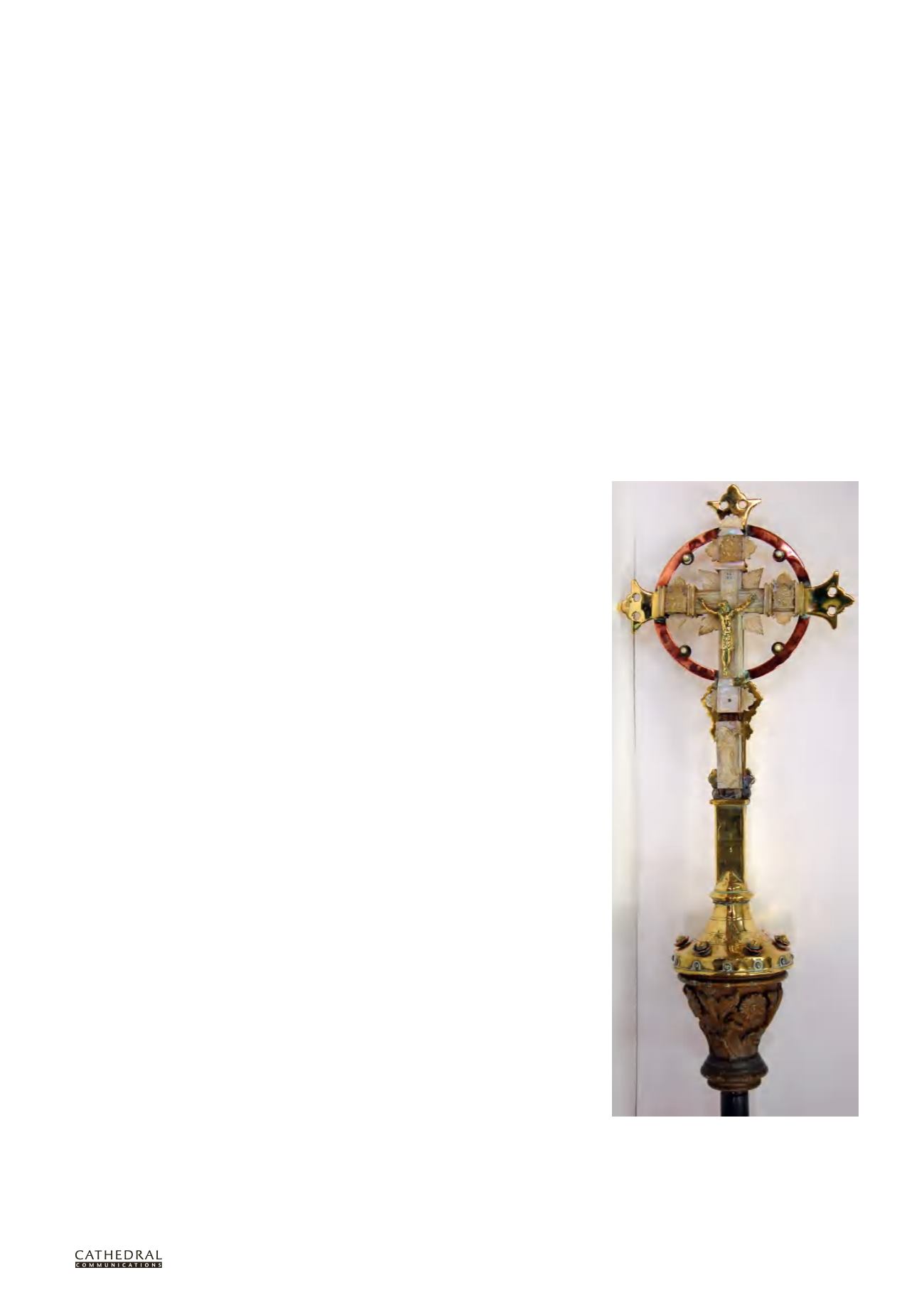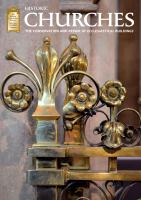

BCD SPECIAL REPORT ON
HISTORIC CHURCHES
22
ND ANNUAL EDITION
25
patchwork quilt of lacquered brass which
remains bright, and unprotected brass
which tarnishes comparatively quickly.
What can harm church brasswork?
The agents of deterioration include high
humidity, which can increase tarnish
and corrosion rates, and salts, which
can be naturally present in coastal
areas but can also come out of walls
and floors if there is a lot of moisture
movement through the building fabric,
and which also encourage corrosion if
they come into contact with metal.
Handling brass with the bare hands
transfers oils, salts and acids to the metal
surface and these can interact with the
brass over time to cause finger-marking,
tarnishing and corrosion. Of course,
many of those who attend church cannot
be asked to wear gloves simply to keep
the brassware bright, but the staff and
volunteers who care for church furnishings
can certainly aid matters if they wear
gloves when handling bright metals.
Cotton gloves are good for the job, but
can be slippery, so some come with special
rubber dots on the surface to increase
grip. Household rubber gloves are useful
as they are hard-wearing, but they are not
very sensitive. Disposable latex gloves are
useful but can become uncomfortable if
worn for long periods, and some people
are allergic to latex. Disposable nitrile
gloves such as those used in the medical
professions (Kimberley-Clark purple nitrile
exam gloves for example) are very useful
for collection care work as they combine
comfort with protection of both the skin
and the objects being handled.
Candle wax is rather acidic and will
react with the copper in brass to produce
green corrosion products, so should not
be left in contact for long periods of time.
Other acidic materials such as wine and
foodstuffs can also attack brass, causing
pitting and corrosion if left in contact
with the surface.
Soiling is a problem, as dust and dirt
are abrasive, and contain materials which
encourage tarnishing and corrosion, or
when in contact with metals act as sites
where corrosion problems can start. If
candles are used in the buildings, the soot
they produce can slowly build up and
soil surfaces, but this is perhaps less of a
problem than it once was.
Inappropriate cleaning materials can
harm brass by cleaning too aggressively,
removing a thin layer of metal each time
the object is cleaned; this can eventually
cause the loss of surface detail, especially
on decorated pieces. Cleaning and
polishing materials can also leave residues
on the surface and in recesses, often in
the form of white deposits of abrasive
powders that have not been properly
removed. Finally, accidental damage such
as scratching, denting or breakage is
always a risk, especially when objects are
handled or moved.
CARE OF BRASS
When caring for brass artefacts, the best
place to start is an assessment of the
object’s condition from a conservation
perspective. Each artefact is different, with
variations in design and manufacture, in
decorative surface detail and in current
finish or patina, as well as in the way it is
used in the church or elsewhere. These
variations all contribute to decisions about
what care methods to use.
For example, a pair of candlesticks
might be small and have a bright finish
showing signs of past polishing; in such
cases light cleaning might be best. An item
might be very large and anyone deciding
to embark on a mission to clean and polish
it top to bottom might be looking at a full
day’s work or even more; is there time
available to do a good job? An item might
show signs of gilding or lacquering or
another surface finish which means that
simply applying a metal polish might cause
damage or be ineffective; further advice
and discussion might be needed. An item
might show patchy tarnish and finger-
marking which will benefit from the careful
application of the right sort of polish.
Or a brass item might show a deeply-
coloured and even coat of tarnish which is
aesthetically pleasing in its own right.
Such patinas can become part of the
long-term appearance of the artefact and
thoughtlessly assuming that ‘all brasswork
must be bright’ can lead to the loss of an
appearance treasured by others. A non-
brass related example would perhaps
be the cleaning of the Sistine Chapel
frescoes which led to many complaints
that they had been over-cleaned and that
deliberately-applied materials had been
lost along with the soiling.
If your brass is already bright and
clean, the best way to manage it is by
timely maintenance with light methods of
cleaning such as dusting and buffing with
a soft cloth. Keep items clean and free
of dust and dirt as far as possible; don’t
leave food and drink residues on brass
plates and cups. Often a wipe over with
a damp cloth is sufficient to clean items.
Flatware such as plates can be immersed
in water with a little washing-up liquid
for cleaning, but items with more of a
three-dimensional shape may contain
voids or even structural elements such as
iron rods holding the parts together and
immersion is best avoided as any water
that gets trapped can cause corrosion. In
such cases, wiping with a cloth moistened
in warm water with a drop or two of
washing-up liquid is probably best.
Brass artefacts known to have
lacquered surfaces can also be gently
cleaned with a damp cloth.
Wax can be a problem on candlesticks
and other surfaces, and trying to remove
it using tools can cause severe damage
to the brass below. There are many
recipes for removing wax with both
freezing and application of hot water
being popular options. It is usually best
to use a hairdryer or a hot air blower
set to the temperature that will melt the
wax without overheating the object. As
the wax melts, it can be wiped up with a
paper towel and disposed of. Any waxy
residues can often be removed with a
towel moistened with a little white spirit,
a solvent which should be safe on all metal
surfaces. Follow safety advice and wear
Detail of a fine processional cross from St Margaret’s
Episcopal Church, Aberdeen, before consolidation
and repair: dated 1878, it is a composition of earlier
pieces, including a brass crucifix believed to be
15th or 16th century and mother of pearl carvings
depicting the evangelists. (Photo: Will Murray)
















